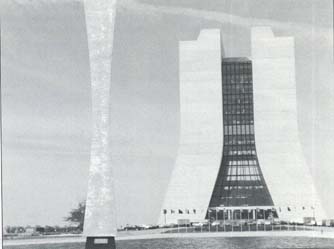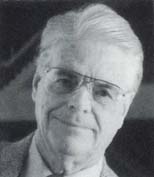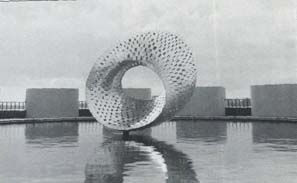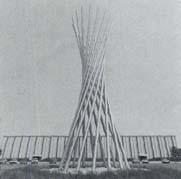History and Heritage of Proton-Beam Therapy: Robert R. Wilson
That citation appears in many papers written by proton therapy researchers and practitioners, in acknowledgement of its pioneering nature. A small addition to the scientific literarure, it became one of the building blocks -- some would say the cornerstone -- of proton-beam radiation therapy.
Science is a cooperative venture whose lifeblood is open communications, openly conducted; it is probably inaccurate and unfair, therefore, to single out Robert Rathbun Wilson, PhD, as the founder of proton-beam therapy. Indeed, Dr. Wilson himself would disown any such identification. Speaking of Ernest O. Lawrence, Wilson (in his book, Accelerators, with Raphael Littauer, New York: Doubleday Anchor. 1960) notes that high-energy particle accelerators represent "Lawrence's dream and its fulfillment." He then says: "Such a statement is an exaggeration, of course, for the science of high-energy nuclear physics has had many roots. Even the part of it most intimately associated with Lawrence -- particle accelerators -- grew from the inspired efforts of hundreds of physicists, each with his own vision." Dr. Wilson undoubtedly views his contributions to proton-beam radiation therapy in the same light.
Still, Dr. Wilson's 1946 paper was seminal. He published it in the medical literature, to acquaint medical and biological workers with the possibilities of high-energy charged particles. He identified the characteristics of proton beams which had enormous potential for patient treatments: low skin dose; well-collinated beams; easily controllable range in tissue; and precision exposure of defined target volumes. He described how the accelerators then under construction could produce such beams. His article got the attention of radiation therapists and other physicians. Proton beams began to be used therapeutically in the mid-1950s; the Proton Treatment Center at Loma Linda is a direct descendant of the interest generated by Wilson's paper.
Dr. Wilson's interest in the medical use of high-energy particles grew out of the neutron therapy work he witnessed at the University of California, Berkeley, where he was an undergraduate and graduate student in the 1930's. In addition, as he said in his 1946 paper, many physicists were aware that the accelerators being built after the Second World War would yield charged particles with enough energy to penetrate deeply into tissue. The implications were obvious.
Robert Wilson was born in Frontier, Wyoming, in 1914. Spending part of his growing years on a ranch, he loved the land and its creatures, and has had lifelong affection and respect for horses. He also frequented the ranch blacksmith shop, where he made things for the pure pleasure of it and, like many others who chose physics for a career, wondered how things work, and why.
That sense of wonder was whetted in 1932 when, a freshman at Berkeley, he became fascinated with the goings on in the old Radiation Laboratory on the campus. He often was late for his chemistry laboratory course because he spent so much time peering into the windows of the "Rad Lab." One day Dr. Frank Exner, a radiologist from Columbia University who was doing research at Berkeley, invited him in and showed him around, explaining the apparati and the experiments being done. Wilson was hooked. He did his undergraduate and graduate work at Berkeley, receiving his PhD in 1940.
As a graduate student, Wilson worked out the theory of the cyclotron, measured the penetration of protons into various materials, and began measuring the scattering of protons by protons. Upon graduation he became an instructor at Princeton and, with the Second World War imminent, became involved with Enrico Fermi's efforts to build a nuclear reactor. In 1943 he joined Los Alamos Laboratory, just then being formed to build the first atomic bomb. He helped organize the laboratory and brought his Princeton colleagues there to form the Cyclotron Group. He became head of the Los Alamos Research Division in 1944, with responsibility for experimental nuclear physics and, later, for the nuclear measurements which were made during the test of the bomb.
After the war, in 1945, Dr. Wilson accepted a teaching position at Harvard, where he helped design the university's cyclotron. It was during that effort that he suggested the radiological use of high-energy protons for cancer therapy. In 1947 he became Cornell University's Director of Nuclear Studies. At Cornell, he and his colleagues built a succession of electron synchrotrons, culminating in a ten-biIlion-electron-volt (10 GeV) machine in 1967. The Cornell 1.2 GeV electron synchrotron of 1953 pioneered the strong-focussing principle, and its energy made possible a new generation of nuclear studies.
At Cornell, Wilson and his colleagues made numerous discoveries. They investigated several "excited states" of the proton; they measured the production of K-mesons by an x-ray beam; they studied the scattering of electrons by protons. The latter investigations determined the shape of the proton and neutron, and confirmed the point-like structure of the electron.
In 1967, Dr. Wilson accepted the directorship of the National Accelerator Laboratory, which later was named for Enrico Fermi. He held the position through the laboratory's founding, the construction of a 500 GeV proton accelerator, and the accelerator's use in over 250 experiments, including those on the interaction of neutrinos with matter and the discovery of a new particle of the proton, the "b quark." He also worked on the design of the Fermilab Tevatron, a system of superconducting magnets which raised the energy of the proton synchrotron at Fermilab to one trillion electron volts (1000 GeV or 1 TeV). This machine was built and is still capable of producing the highest-energy particle collisions in the world, though the superconducting supercollider (SSC) will surpass it.
Dr. Wilson guided Fermilab through its first decade. He influenced not only the Laboratory's research efforts but also the physical appearance of the facility itself.
Dr. Wilson is an accomplished sculptor as well as physicist. The roots of his loves for physics and sculpture probably reside, he says, in the pleasure he experienced as a boy, making things in the ranch blacksmith shop. Building scientific artifacts gave him the same sense of satisfaction, and, while a graduate student at Berkeley, he embellished that satisfaction by going to the "Rad Lab" at night and building "big, scary figures from whatever was lying around," leaving them for people to find next day. He carved horses of wood and sculpted figures of his children. "I was always making things," he says.
Throughout his scientific career, Dr. Wilson created art as well. In 1960 he spent a sabattic year at the Academia Belli Arte in Rome, formally studying sculpture. He was commissioned to do several pieces and even considered leaving his physics profession to concentrate on his art. In 1967, however, the opportunity came to help create the National Accelerator Laboratory. As a physicist, Wilson relished the chance to create tools which would extend discoveries in the inner space of the atomic nucleus. And as an artist, Wilson saw the Illinois cornfields, which were to be the site of the laboratory, as a blank canvas.
What evolved under Dr. Wilson's influence is a collection of striking structures set within the context and contours of the land. The shapes of the Fermilab buildings suggest the work done in each. Curves are everywhere: in the buildings; on the roads; even in the pi-shaped powerline poles. The Tevatron ring, four miles in circumference, is buried in the earth, but a berm reveals its presence and encloses a tallgrass-prairie restoration. The berm is there for aesthetic reasons as well as for the functional purpose of radiation shielding; the ring could have been buried completely, but Wilson chose otherwise.
Fermilab's sixteen-story central laboratory, now named Robert Rathbun Wilson Hall, is the dominant structure on the campus. Viewed head-on, its sweeping walls and encompassed expanse of glass suggest a Gothic cathedral and it was, in fact, inspired by the cathedral at Beauvais. Like the classic cathedrals, the soaring space in the atrium is well-suited for musical performances, and many musical events are held there as well as in the adjoining Ramsey Auditorium, which was designed with acoustics in mind. Dr. Wilson played an intimate part in both buildings' design. One example of his input is the staircase in the atrium of Wilson Hall: it affords a changing vista of the countryside around and the sky above as Fermilab workers use it for moving from floor to floor and, often, for daily exercise. Outside, Wilson's "Hyperbolic Obelisk" echoes the shape of the central laboratory.
In another of the Laboratory's buildings, the proton control structure, another staircase reflects Wilson's influence. The yellow spiral recalls the DNA double helix. Radiation oncologists may find the staircase more than a little suggestive, since DNA strand breaks are one of the mechanisms whereby ionizing radiation kills cells.
Several of Dr. Wilson's sculptures are found elsewhere at the laboratory. Entering Fermilab's main driveway, one passes under "Broken Symmetry," a piece constructed from parts of a battleship and one which symbolizes what physics means for Wilson: the search for order in symmetrical relationships of knowledge, and then for deeper knowledge when that symmetry is found to be slightly broken. This piece, like most of Wilson's work, conveys a sense of rising, soaring and flowing, admixed with curves that suggest a return to the source. Even when Wilson's materials have sharp edges, the final creation evokes a smoothing -- one might say soothing -- sensation.
Dr. Wilson's sculptures are found at several sites around the nation besides Fermilab. Examples reside at Princeton and Harvard, in Ithaca, New York, where he lives, and in many private collections.
In his academic life, Dr. Wilson has held a variety of appointments and has received several honors. He has been a faculty member at a number of great American universities including the University of Chicago; Princeton, Harvard and Columbia Universities; and twice at Cornell, where he now is emeritus professor of physics. In 1954 he was Exchange Professor at the University of Paris. He has been the recipient of Guggenheim and Fulbright Fellowships, and has received honorary degrees from Harvard, North Central College, Wesleyan, Notre Dame and the University of Bonn. He received the Elliot Cresson Medal in 1963, the National Medal of Science in 1973, the Fermi Award in 1984, and the Juan A. del Regato Award in 1989. He is a member of the American Physical Society and was its president in 1985. He also is a member of the National Academy of Sciences, the American Academy of Arts and Sciences, and the American Philosophical Society. He helped organize and twice chaired the Federation of American Scientists.
Robert Wilson today lives in a house on the edge of a gorge in Ithaca, far above Cayugas waters. From his home Wilson can enjoy a grand vista, suitable for one who is still a Westerner at heart. He remains deeply involved in science and art, though he resists being identified as wholly a scientist or an artist. He melds the two, and includes interests in politics, philosophy and nature. As he puts it: "One tries to be a whole person, and that involves all sorts of facets - some more important than science or art."
When Dr. Wilson received the del Regato Award at Loma Linda University in 1989, he expressed pleasure at the Proton Treatment Center that was then approaching completion. It was immensely gratifying, he said, to see a particle of his life's work being put to use for the potential benefit of so many people. Recalling his days at Los Alamos during the Manhattan Project he remarked, "I never liked the idea of helping to make a bomb." That phrase recalled a scene from Surely Your Joking, Mr. Feynman, wherein the late Nobel physicist, Richard Feynman, described the day of the Trinity test at Alamogordo, New Mexico, in 1945. The first atomic bomb had been detonated, and everyone was jumping up and down with excitement that the thing had worked. Everyone but Wilson. Feynman asked him why.
"It's a terrible thing we've made," Wilson replied.
Robert Wilson felt despair that day. National emergency or no, it cut deeply against his essential grain to see such destructiveness result from his work. His whole life was, and is, attuned to creation, to understanding nature so that one might participate in its ever-creating miracle. In his own words, "Creativity is a life-affirming activity that contributes to the precious quality of life: of the individual; of the nation; of all of us."






